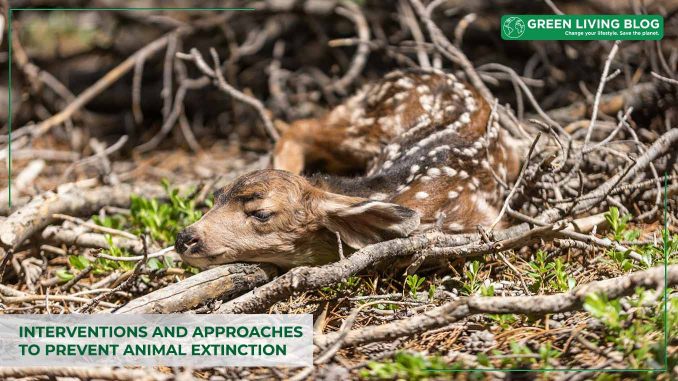
Even though the United Kingdom is well known for its abundant biodiversity, the unfortunate reality is that one species out of every six is at risk of going extinct.
By drawing attention to the critical need for conservation activities that are both comprehensive and coordinated throughout the nation, this alarming statistic brings to light the critical importance of such measures.
To shine a light on the essential activities that are required for business sectors, industries, and the general public to perform to establish collective and effective conservation efforts, the objective of this book is to shine a light on such acts.
The investigation of the use of environmental DNA (eDNA) and other technological breakthroughs will be how this objective will be attained.
This post delves into the most significant strategies and innovative approaches that are now accessible to combat the extinction of animals in the United Kingdom.
1. The preservation of natural Habitats and Locations

When it comes to the fight against the extinction of animals, the conservation of natural ecosystems is of the biggest significance. The United Kingdom’s long and famous history of industrial and agricultural expansion has caused significant harm to the country’s biodiversity, which is presently listed among the lowest in the world. Other countries have also suffered significant damage to their biodiversity.
Because agriculture occupies more than seventy per cent of the land area in the United Kingdom, it is impossible to overstate the significance of using environmentally responsible farming practices. This section discusses several initiatives that are regarded to be creative. Some of these initiatives include land sharing, regenerative farming, and habitat restoration.
To strike a good balance between agriculture and the preservation of biodiversity, these practices are very necessary. The effective case studies are highlighted, and steps are provided for the more widespread implementation of these practices.
2. Combating illegal Trade and Poaching is an ongoing Fight
Although poaching is less prevalent in the United Kingdom in contrast to other countries, the global issue of illegal wildlife trade continues to influence the species that are native to the United Kingdom. In addition to the execution of harsh consequences for those who commit crimes, it is also important to increase law enforcement and promote international coordination. Both things are highly vital.
At the same time, this section highlights the significance of public awareness initiatives in terms of their ability to reduce the demand for animal products that are acquired illegally. To do this, it provides examples of programs that have been successful and investigates how technology and community engagement might further aid in reducing the incidence of this pervasive issue.
3. Keeping in accordance with the Policies and Laws established for Conservation

Legislation is a very significant issue to consider when it takes into consideration the protection of animals. A significant amount of progress has already been made by the United Kingdom. This progress has been accomplished via the adoption of many environmental rules and involvement in international agreements created to protect endangered species. A debate is conducted in this section regarding the relevance of retaining support for these laws, with an emphasis focused on the need to ensure that they are implemented and enforced effectively.
In addition to this, it studies how involvement in economic conservation measures, such as legislation protecting habitats, makes a significant contribution to wider efforts to conserve biodiversity. Specifically, it focuses on the way these approaches are used. In addition to offering examples of legislation that has a substantial impact, it also offers policy recommendations for the formation of future law.
4. Using Environmental DNA (eDNA) in Combination with Modern Technology
It has become feasible to perform ground-breaking research and monitoring of endangered species because of recent technology breakthroughs, particularly electronic DNA. The technique of electronic DNA analysis involves the collecting of DNA from ambient samples to identify species without the requirement for physical capture or observation thanks to more technological breakthroughs, such as drones, genetic conservation techniques, satellite remote sensing, automated bioacoustic monitoring systems, and video traps, among others.
The relevance of these technologies in the context of targeted conservation efforts is highlighted via the examination of detailed case studies and insights into the way these technologies provide trustworthy data on habitats, population numbers, and behaviors.
5. A Few of the Challenges and Accomplishments

A wide range of animal species have been severely impacted because of the decline in the number of animal populations in the United Kingdom. A sad image of the current state of biodiversity in the United Kingdom is shown, which includes the fact that almost half of the native bird species and twenty-five percent of the animals are at risk of going extinct at this very moment.
Despite this, many accounts of hope and victory may be discovered amid these challenges. By emphasizing the recovery of freshwater invertebrates and specialized conservation efforts that have led to the stabilization or increase of certain species populations, this part of the book aims to inspire and support continued conservation initiatives. It does this by showcasing the recovery of these species. The use of these strategies has resulted in the maintenance or expansion of the populations of some species.
Conclusion
To effectively counteract the pace of animal extinction in the United Kingdom, it is essential to use a variety of different strategies. It is recommended that this strategy include both traditional methods of conservation as well as the use of innovative technology. To maintain its remarkable biodiversity, the United Kingdom must take several vital initiatives, including the protection of natural habitats, the prevention of illegal trade, the advocacy for conservation laws, and the use of cutting-edge technology such as eDNA.
The survival of the species that are the focus of these efforts is not the only reason why these efforts are necessary; they are also necessary for the overall health of ecosystems and the benefits that ecosystems continue to provide to people to ensure a sustainable future for the wildlife of the United Kingdom.
![]()
Author Profile
- Online Media & PR Strategist
- Blogger and Educator by Passion | Senior Online Media & PR Strategist at ClickDo Ltd. | Fascinated to Write Lifestyle Blogs in News & Education I have completed a journalism summer course at the London School of Journalism and manage various blogs.
Latest entries
 LeisureApril 16, 202510 Best Green UK Hotels for Eco-Tourists
LeisureApril 16, 202510 Best Green UK Hotels for Eco-Tourists Best practicesApril 14, 20258 Best Ways to Reduce Your Carbon Footprint
Best practicesApril 14, 20258 Best Ways to Reduce Your Carbon Footprint Green Expert GuidesMarch 28, 2025Lisbon Living: Where Sustainable Charm Meets Urban Energy
Green Expert GuidesMarch 28, 2025Lisbon Living: Where Sustainable Charm Meets Urban Energy EnvironmentJanuary 21, 2025Buying Eco-Friendly Homes: 6 Eco Questions to Ask Your Real Estate Agent
EnvironmentJanuary 21, 2025Buying Eco-Friendly Homes: 6 Eco Questions to Ask Your Real Estate Agent






Leave a Reply
You must be logged in to post a comment.